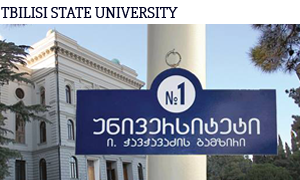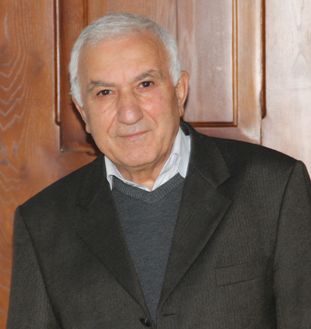
FACULTY OF EXACT AND NATURAL SCIENCES
GEOLOGY AND PROBLEMS OF THE VARDZIA CAVE MONASTERY COMPLEX
The Vardzia monastery complex is located in the extreme southwest of Georgia on the left bank of the Mtkvari River near the Turkish-Georgian border. It is 1300 m above sea level and belongs to the Aspindza Municipality of the Meskheti Region. The monastery dates to the 12th-13th centuries (1156-1203). Since 2007, by nomination of the Ministry of Culture and Monument Protection of Georgia, the monument is on the provisional list for inclusion in UNESCO’s World Heritage List. Today this cultural heritage monument faces serious threats however.
Professor Bezhan Tutberidze, Head of the Department of Geology at the TSU Faculty of Exact and Natural Sciences, and Doctor of Geological Sciences, has studied the geological problems of the Vardzia monastery complex for several years. The monolithic city of the Vardzia monastery complex has been endangered for centuries and is still at risk of endogenic (earthquakes, tectonic movements) and exogenic (erosion) geological processes. Several earthquakes have taken place in the region, of which the most disastrous was in 1283 when a 15-meter layer broke away from the wall of the complex and two – thirds of the total area was damaged. Aggressive exogenic processes actively cause bedrock disruption as well, with sharp changes in climatic conditions – – especially rain, snow, snow runoff and groundwater – that destroy this massive rock city. In addition to geological processes, armed conflicts that the monastery faced for centuries contributed to its destruction. Vardzia is an excellent example of the unity of a volcanic and a cultural landscape, characterized by a complex geology.
 Each year the National Agency for Cultural Heritage Preservation carries out rehabilitation work to protect the monument; however these need to be accelerated and expanded to preserve the monument. The government has developed a comprehensive program for the survival and development of the Vardzia monument, a program with multiple components; it is being implemented by Georgian and foreign experts and will include rock fall prevention. These works are led by Claudio Margottini, Italian engineering geology expert and consultant at UNESCO, and Vice President of International Consortium on Landslides, Professor of Engineering Geology for the Conservation of Cultural Heritages. Under an agreement concluded between the National Agency for Cultural Heritage Preservation of Georgia and TSU, the Department of Geology carried out research to determine the mineralogical composition and structural and textural peculiarities of bedrock at Vardzia.
Each year the National Agency for Cultural Heritage Preservation carries out rehabilitation work to protect the monument; however these need to be accelerated and expanded to preserve the monument. The government has developed a comprehensive program for the survival and development of the Vardzia monument, a program with multiple components; it is being implemented by Georgian and foreign experts and will include rock fall prevention. These works are led by Claudio Margottini, Italian engineering geology expert and consultant at UNESCO, and Vice President of International Consortium on Landslides, Professor of Engineering Geology for the Conservation of Cultural Heritages. Under an agreement concluded between the National Agency for Cultural Heritage Preservation of Georgia and TSU, the Department of Geology carried out research to determine the mineralogical composition and structural and textural peculiarities of bedrock at Vardzia.
Samples of the bedrock selected by international experts from the Vardzia complex underwent studies to establish the general geological character of the site, with a detailed petrological investigation; full standard silicate chemical analysis of rocks and petrochemical interpretation of the results; identification of rocks; and possible secondary replacement processes. Vardzia was hewn in a volcanogenic-sedimentary suite built up from facies of a lower pyroclastic subsuite from the Late Miocene “Goderdzi suite”.
“From a lithological point of view, the Goderdzi suite is divided into pyroclastic and lava subsuites. The Vardzia complex is hewn into a 40-60m thick massive, sometimes cross-bedded tuff packet. Macroscopic examination shows that the tuffs are light gray, white or yellow, light, porous rocks with enhancing features. They are easily subject to processing and are characterized by a high degree of cementation and resistance to weathering agents. Visual inspection makes it possible to view various-sized fragments of rock-forming minerals, rocks and white pumice. Microscopic analysis shows a variety of fragments in Vardzia-type tuffs: lithoclastic (rock fragments), crystalloclastic (crystal and mineral fragments), vitroclastic (volcanic glass fragments) and mixed varieties. Tuffs are characterized by intricate grain-size composition (by size of fragments). Lithoclastic and litho-crystalloclastic tuffs of psammite-psephite types are more commonly found than pelite-alevrite vitrocrystalic tuffs. According to the data of a complete silicate chemical analysis, the tuff composition corresponds to andesites and dacites. The presence of clays can be found in replacement products. The tuff is ignimbrite by nature (‘ignimbrite’ – from the Latin igni – (fire) and imbri – (rain), pyroclastic rocks welded at a high temperature), sedimented in sub-continental, shallow lake basins and known as “Vardzia type tuffs”.
The Vardzia tuffs are covered by 18-25 m tuff breccias (a volcanogenic sedimentary rock consisting of angular or, less frequently, slightly rounded fragments of extrusive rocks that range in size from blocks of several cubic meters to particles the size of grains of sand, cemented together by fine volcanic ash). According to the microscopic analysis and chemical data, the breccia composition corresponds to andesites (basically) and dacites. Volcanic breccias create steep rocky slopes with a system of joints overlying the tuffs. Erosion caused by seasonal water flows and temperature variations in tuff-breccia rocks reduces the quality of rock cementation, promotes ever-widening cracks and accelerates the process of selective weathering of bedrock, which ultimately disturbs the stability and balance of the slope and creates the conditions for slope disruption, including landslides and avalanches. Besides the collapse of small separate fragments provoked by the non-homogeneous composition and uneven cementation of rocks, there is an increasing hazard from large block failure that could substantially alter the structure of the monument and endanger visitor safety.
Recommendations were made to stop the development and action of natural hazards of geological nature. Studies must be carried out to assess the physical-mechanical and collector properties of the breccia-suite rocks, and to determine replacement quality and speed. To maintain the balance of the steep slope of the monastery complex and avoid side and abyssal erosion in breccia-suite cracks and fractures, it is crucial to intensify the regulation of water flow and reinforce riverbeds. Special attention should be given to the dynamics of chemical weathering processes in the tuffs of the site, as the products of these processes are clays, which significantly weaken the structure of rock and create a serious potential for the tuff to disintegrate.
The results of this research were presented at the National Agency for Cultural Heritage Preservation of Georgia in December 2014. In 2014 Professor Tutberidze participated in IAEG XII Congress in Torino – “Engineering Geology for Society and Territory”. An article about the geological problems of the Vardzia cave monastery complex was published in the congress publications. It was included in Thomson Reuters database: Engineering Geology for Society and Territory – volume 8, Preservation of Cultural Heritage, 2015). In 2012 and 2014 Professor Tutberidze made presentations at international meetings dedicated to the survival of Vardzia (October 16-19, 2012, Vardzia; July 7-9, 2014, Vardzia).




